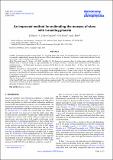Files in this item
An improved method for estimating the masses of stars with transiting planets
Item metadata
| dc.contributor.author | Enoch, B. | |
| dc.contributor.author | Collier Cameron, A. | |
| dc.contributor.author | Parley, N.~R. | |
| dc.contributor.author | Hebb, L. | |
| dc.date.accessioned | 2014-01-16T11:31:00Z | |
| dc.date.available | 2014-01-16T11:31:00Z | |
| dc.date.issued | 2010-06 | |
| dc.identifier | 5849705 | |
| dc.identifier | 4a9639ed-1149-48e2-a9ad-0c498adad25c | |
| dc.identifier | 77957827731 | |
| dc.identifier.citation | Enoch , B , Collier Cameron , A , Parley , N R & Hebb , L 2010 , ' An improved method for estimating the masses of stars with transiting planets ' , Astronomy & Astrophysics , vol. 516 , A33 . https://doi.org/10.1051/0004-6361/201014326 | en |
| dc.identifier.issn | 1432-0746 | |
| dc.identifier.other | Bibtex: urn:18175f0ddc8e7b7c23e85c37fe1ddb8f | |
| dc.identifier.other | ORCID: /0000-0002-8863-7828/work/58531425 | |
| dc.identifier.uri | https://hdl.handle.net/10023/4377 | |
| dc.description.abstract | Context. To determine the physical parameters of a transiting planet and its host star from photometric and spectroscopic analysis, it is essential to independently measure the stellar mass. This is often achieved by the use of evolutionary tracks and isochrones, but the mass result is only as reliable as the models used. Aims. The recent paper by Torres et al. (2010, A&ARv, 18, 67) showed that accurate values for stellar masses and radii could be obtained from a calibration using Teff, log g and [Fe/H]. We investigate whether a similarly good calibration can be obtained by substituting log ρ – the fundamental parameter measured for the host star of a transiting planet – for log g, and apply this to star-exoplanet systems.Methods. We perform a polynomial fit to stellar binary data provided in Torres et al. (2010) to obtain the stellar mass and radius as functions of Teff, log ρ and [Fe/H], with uncertainties on the fit produced from a Monte Carlo analysis. We apply the resulting equations to measurements for seventeen SuperWASP host stars, and also demonstrate the application of the calibration in a Markov Chain Monte Carlo analysis to obtain accurate system parameters where spectroscopic estimates of effective stellar temperature and metallicity are available. Results. We show that the calibration using log ρ produces accurate values for the stellar masses and radii; we obtain masses and radii of the SuperWASP stars in good agreement with isochrone analysis results. We ascertain that the mass calibration is robust against uncertainties resulting from poor photometry, although a good estimate of stellar radius requires good-quality transit light curve to determine the duration of ingress and egress. | |
| dc.format.extent | 5 | |
| dc.format.extent | 134760 | |
| dc.language.iso | eng | |
| dc.relation.ispartof | Astronomy & Astrophysics | en |
| dc.subject | Planetary systems | en |
| dc.subject | Photometric analysis | en |
| dc.subject | Spectroscopic analysis | en |
| dc.subject | Stellar mass | en |
| dc.subject | QB Astronomy | en |
| dc.subject.lcc | QB | en |
| dc.title | An improved method for estimating the masses of stars with transiting planets | en |
| dc.type | Journal article | en |
| dc.contributor.sponsor | Science & Technology Facilities Council | en |
| dc.contributor.sponsor | Science & Technology Facilities Council | en |
| dc.contributor.institution | University of St Andrews. School of Physics and Astronomy | en |
| dc.identifier.doi | 10.1051/0004-6361/201014326 | |
| dc.description.status | Peer reviewed | en |
| dc.identifier.grantnumber | ST G001987 1 | en |
| dc.identifier.grantnumber | PP/F000065/1 | en |
This item appears in the following Collection(s)
Items in the St Andrews Research Repository are protected by copyright, with all rights reserved, unless otherwise indicated.

